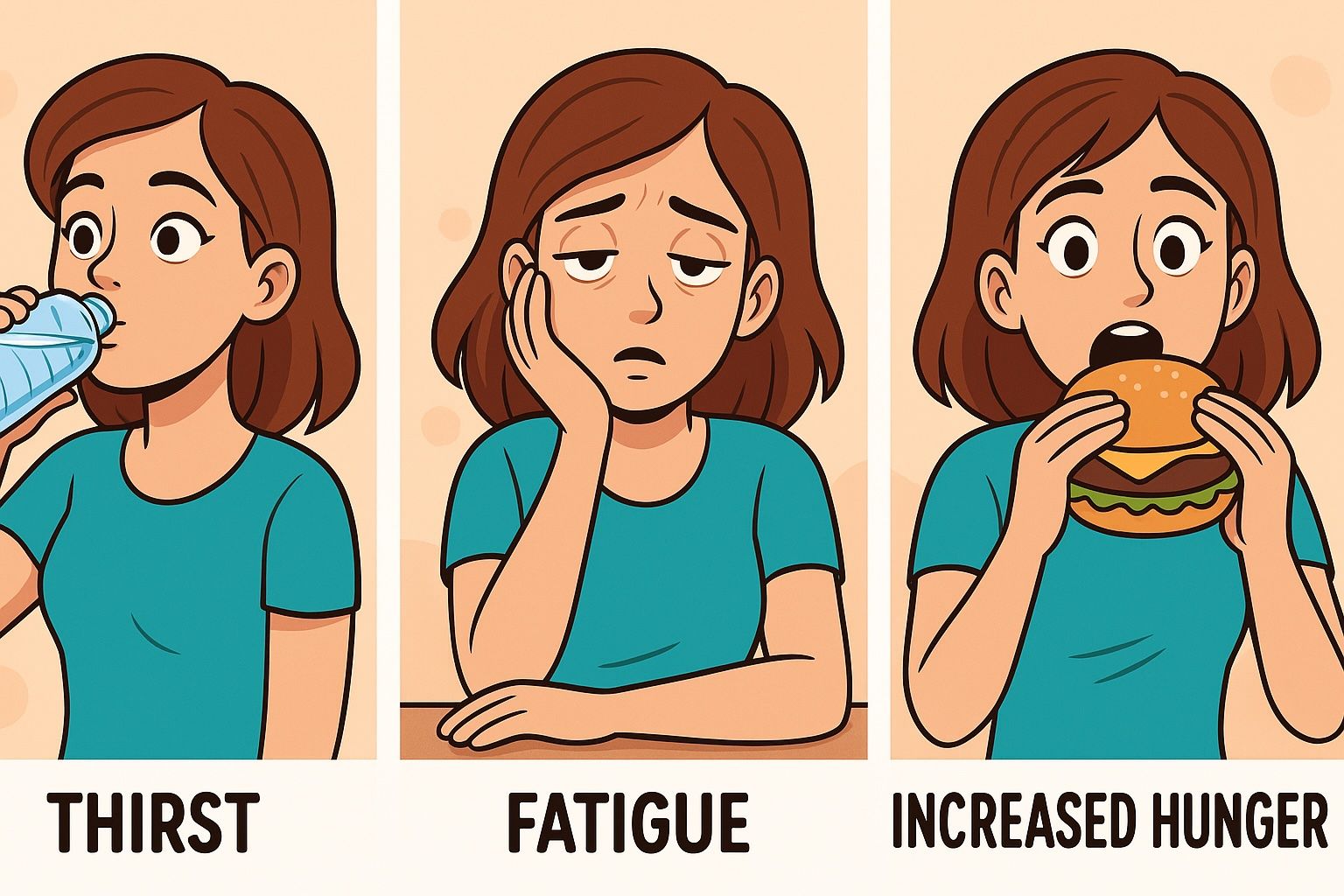Early Warning Signs of Prediabetes: What to Watch For (Especially if It Runs in Your Family)
Published on 10/11/2025 · 📖 8 min read

You don’t wake up one day with prediabetes.
It’s a slow, quiet shift that builds over time — often without any dramatic symptoms. But if you catch it early, you can absolutely turn it around.
The key lies in awareness — noticing the subtle signals your body gives before things get out of hand.
The Subtle Signs to Watch For
If you’ve noticed any of these, it might be time to check in with your doctor:
- Constant thirst: You’re drinking water constantly, but never feel satisfied.
- Frequent urination: Especially waking up several times at night.
- Fatigue: That mid-day crash that hits harder than it should.
- Blurred vision: Things seem just a little off-focus at times.
- Increased hunger: You eat, yet still feel unsatisfied.
According to the Centers for Disease Control and Prevention (CDC), more than 1 in 3 adults in the U.S. have prediabetes, and over 80% don’t know it.¹
These are easy to overlook — which is why so many people don’t realize what’s happening until a routine blood test reveals elevated sugar levels.
Why It Happens
Prediabetes develops when your body starts struggling to use insulin effectively — a condition called insulin resistance.
Insulin is like a key that unlocks your cells to let glucose (sugar) in. When this key stops working well, sugar builds up in your bloodstream. Your kidneys try to flush it out, leading to more urination. That dehydration triggers thirst — and the cycle continues.
Left unchecked, this pattern can eventually progress to type 2 diabetes. But here’s the truth: prediabetes is reversible — and early action makes all the difference.
If It Runs in the Family
Having a family history of diabetes doesn’t mean you’ll get it — but it does mean you should be proactive.
Here’s what helps most:
- Get screened regularly. A simple HbA1c test once a year can catch early changes.
- Be mindful of your meals. Limit refined carbs, sugary drinks, and highly processed foods.
- Move daily. Even a brisk 20-minute walk after meals helps control post-meal spikes.
- Sleep well. Poor sleep can make blood sugar harder to manage.
- Stay consistent. Sustainable habits beat restrictive diets every time.
The National Health Service (NHS) emphasizes that early lifestyle changes can reduce the risk of developing type 2 diabetes by up to 50%.³
When Prediabetes Meets Different Body Types
Prediabetes isn’t just a “weight issue.”
Both underweight and overweight individuals can experience insulin resistance — though the root causes and priorities differ.
Let’s break it down.
For Those Who Are Underweight or Lean
Many people assume being thin protects them from prediabetes — but that’s not always true.
Even if you’re lean, your metabolism can still struggle to use insulin efficiently.
Why It Happens
- Genetics: A strong family history can increase your risk, regardless of your size.
- Muscle loss: Muscle tissue helps your body use glucose effectively. Less muscle means higher sugar swings.
- Visceral fat: Even at a normal weight, fat around internal organs can affect insulin sensitivity.
- Lifestyle factors: Skipping meals, poor sleep, and high stress can all disrupt blood sugar regulation.
Research published in the Journal of Clinical Endocrinology & Metabolism highlights that individuals with low muscle mass may develop insulin resistance despite a normal BMI.⁴
What to Focus On
Your goal isn’t weight loss — it’s metabolic nourishment.
You need to build strength, maintain a healthy calorie intake, and stabilize your blood sugar.
- Rebuild muscle.
- Do light strength training 3–4 times a week.
- Include protein in every meal — eggs, paneer, lentils, fish, tofu, or yogurt.
- Eat balanced, calorie-dense meals.
- Add healthy fats like nuts, seeds, ghee, olive oil, and avocado.
- Choose slow carbs like oats, brown rice, or sweet potatoes.
- Pair every carb with protein or fat to reduce spikes.
- Eat regularly.
Don’t skip meals. Have small, balanced portions every 3–4 hours to avoid blood sugar drops and fatigue. - Rest and recover.
Poor sleep or constant stress can raise glucose levels even if you’re eating well. - Use GlucoSpike AI for awareness.
Instead of restricting food, use it to understand how different meals affect your glucose — and adjust your combinations for stability and energy.
In short: build strength, not restriction.
More muscle and steady nourishment improve insulin sensitivity naturally.
For Those Who Are Overweight or Carry Extra Fat
When extra fat — especially around the abdomen — builds up, it can make your cells more resistant to insulin. That’s why prediabetes is often linked to weight gain, though it’s not the only factor.
Why It Happens
- Visceral fat: The fat surrounding your organs releases hormones that interfere with insulin.
- Sedentary habits: Sitting too much and moving too little make it harder for muscles to use glucose.
- High-carb processed diets: Frequent spikes from sugary or refined foods tire out your insulin response.
- Chronic stress: Cortisol (the stress hormone) raises blood sugar levels, especially in those already insulin resistant.
According to the World Health Organization (WHO), moderate weight loss of just 5–7% of body weight significantly improves insulin sensitivity and reduces prediabetes progression.⁵
What to Focus On
Your goal is gradual fat loss while maintaining energy and muscle. Even a 5–7% reduction in body weight can improve insulin sensitivity dramatically.
- Eat for balance, not elimination.
- Prioritize whole foods, fiber, lean proteins, and healthy fats.
- Avoid cutting carbs completely — focus on better carbs like vegetables, millets, lentils, and fruits.
- Move often.
- 30 minutes of walking or activity daily can lower glucose right after meals.
- Add strength training to preserve lean muscle.
- Stay hydrated and sleep well.
- Poor sleep and dehydration both affect blood sugar control.
- Track your progress with awareness tools.
- Apps like GlucoSpike AI help you see how meals impact your blood sugar and how post-meal walks flatten spikes.
- This feedback loop helps you make small, smart changes — without crash diets or guilt.
Remember: the goal isn’t fast weight loss — it’s better metabolism.
The Turning Point
Getting a “prediabetes” diagnosis can feel scary, but it’s actually your body’s way of asking for attention.
It’s not a sentence — it’s a signal.
Many people return to normal blood sugar ranges within months by making consistent, realistic lifestyle changes:
- Building muscle
- Choosing balanced meals
- Walking after eating
- Sleeping enough
- Managing stress
These aren’t dramatic shifts — they’re sustainable ones.
And with the right awareness tools, like GlucoSpike AI, you can understand how your body reacts in real time — which is the first step to long-term control and confidence.
FAQs
Can someone be prediabetic even if they’re thin?
Yes. Prediabetes can affect anyone. Lean individuals can develop it due to genetics, visceral fat, or low muscle mass.
Why does waist-to-hip ratio matter?
It’s a strong indicator of fat distribution. More fat around your midsection — even at a healthy weight — increases insulin resistance.
How can I manage prediabetes without losing more weight?
Eat balanced meals with enough calories, focus on protein and healthy fats, and build muscle through light resistance exercises.
Can prediabetes be reversed?
Yes. With consistent lifestyle shifts — balanced eating, movement, good sleep, and awareness — many people normalize their blood sugar levels.
How does GlucoSpike AI fit in?
It helps you see how your meals affect your blood sugar, shows your spike patterns, and even suggests how long to walk after eating to flatten those spikes.
Final Takeaway
Whether you’re underweight or overweight, prediabetes isn’t just about numbers on a scale — it’s about how efficiently your body handles sugar.
Catching it early gives you the power to reverse it.
With balanced habits, steady awareness, and tools like GlucoSpike AI, you can take charge of your health — not through restriction, but through understanding and nourishment.
This isn’t about fear. It’s about awareness, action, and progress — one meal, one walk, one day at a time.
Just Found Out You’re Borderline Pre-diabetic? Start With These 7 Golden Rules
Medical Disclaimer
This article is for informational purposes only and does not constitute medical advice. It is not a substitute for professional diagnosis or treatment. Always seek the advice of your physician or qualified healthcare provider regarding any medical condition or before making significant lifestyle changes.
References
- Centers for Disease Control and Prevention (CDC). Prediabetes: Your Chance to Prevent Type 2 Diabetes.
- American Diabetes Association (ADA). Standards of Medical Care in Diabetes — 2024.
- National Health Service (NHS). Preventing Type 2 Diabetes.
- Srikanthan, P., & Karlamangla, A. S. (2011). Relative muscle mass is inversely associated with insulin resistance and prediabetes. Journal of Clinical Endocrinology & Metabolism.
- World Health Organization (WHO). Diabetes Fact Sheet.
 GlucoSpike AI
GlucoSpike AI 

